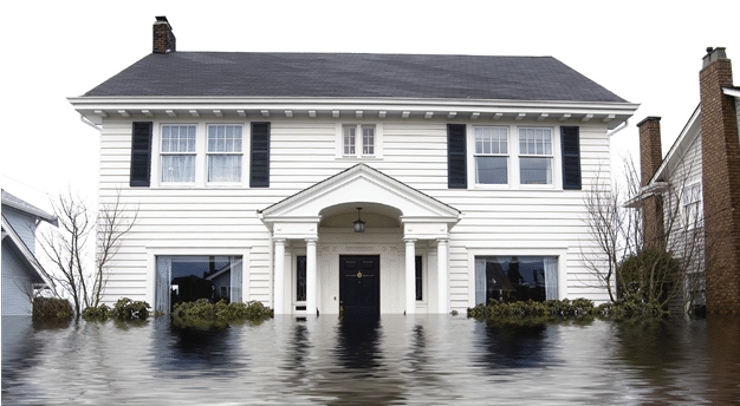GAO Analysis of Risk Rating 2.0 Identifies Areas for Improvement

A new study by the Government Accountability Office into FEMA’s flood insurance rating methodology says that “Risk Rating 2.0 is aligning premiums with risk, but affordability concerns accompany the premium increases.” It’s those competing goals of keeping flood insurance affordable and the NFIP program fiscally solvent that led GAO to conduct the study. Since 2005, FEMA has had to borrow $36.5 billion from the U.S. Treasury.
Released last month, the new 91-page GAO report addresses (1) the actuarial soundness of the new Risk Rating 2.0 methodology, (2) how premiums are changing for policyholders, (3) efforts to make flood insurance affordable for policyholders, (4) options for addressing program debt, (5) the potential implications of Risk Rating 2.0 for the private flood insurance market, and (6) FEMA’s efforts to promote policyholder understanding of Risk Rating 2.0.
In the report, the GAO recommends six matters for congressional consideration and five for executive action by FEMA. All remain open at the time of this writing.
ASFPM has an internal RR 2.0 Workgroup that is working with FEMA to address several issues and concerns that members have raised. In line with what the workgroup is addressing, ASFPM is particularly pleased to see recommendation #5 for FEMA, which calls for more detailed property-specific flood risk information to help policyholders and insurance agents better understand their premium and the potential savings associated with available mitigation options.
GAO also provides matters that Congress should address, which include some ASFPM has pushed for. This includes addressing the NFIP’s debt (i.e., forgive it) and creating a means-tested affordability mechanism that does not create a new subsidy or cross-subsidy within the NFIP. (Read our NFIP priorities here.)
GAO Outlines Matters for Congressional Consideration
- Congress should consider authorizing and requiring FEMA to incorporate the reserve fund assessment, to the extent necessary based on actuarial principles, into the risk charge within the full-risk premium.
- Congress should consider repealing the HFIAA surcharge and authorizing and requiring FEMA to replace forgone revenue with actuarially determined premium adjustments.
- Congress should consider providing any affordability assistance for flood insurance through a means-based program that is reflected in the federal budget rather than through statutorily discounted premiums. Options that Congress might consider include allowing assistance to be used for private policies and shortening or ending the period of discounted premiums for those that do not qualify for assistance.
- Congress should consider addressing NFIP’s legacy and potential future debt and should consider the best means for doing so. Options for addressing the legacy debt include canceling the debt or creating specific repayment terms funded by a transparent premium surcharge. Options for addressing future debt include providing funding to make up for the statutorily-generated premium shortfall, allowing immediate transition to full-risk rates accompanied by a means-based assistance program, changing the financing of catastrophic losses, and enabling FEMA to purchase additional reinsurance.
- Congress should consider authorizing and requiring FEMA to allow private flood insurance coverage to satisfy NFIP’s continuous coverage requirement.
- Congress should consider authorizing and requiring FEMA to offer risk-based partial refunds for midterm cancellations of NFIP policies that are replaced by private flood insurance policies and authorizing and requiring FEMA to implement these refunds in an actuarially sound manner.
GAO Recommendations for Executive Action by FEMA
- The Assistant Administrator of FEMA’s Federal Insurance Directorate should adjust CRS by calculating a community’s rating based only on community activities that reduce flood risk and by incorporating discounts into the full-risk premium based on the actuarial evaluation of risk reduction.
- The Assistant Administrator of FEMA’s Federal Insurance Directorate should evaluate other means for incentivizing desirable community activities that cannot be actuarially justified but are currently a basis for discounts in CRS.
- The Assistant Administrator of FEMA’s Federal Insurance Directorate should publish an annual actuarial report that includes the loss levels that full-risk premiums are designed to cover and that current discounted premiums are able to cover, and the associated uncertainty; the estimated premium revenue and shortfall for current and future years; and an evaluation of NFIP’s fiscal outlook, including projections of future debt.
- The Assistant Administrator of FEMA’s Federal Insurance Directorate should take steps to directly inform individual policyholders about Risk Rating 2.0 and make them aware of available information.
- The Assistant Administrator of FEMA’s Federal Insurance Directorate should take additional steps to make available to policyholders, agents, or both more detailed property-specific flood risk information to help them better understand the justification for individual premiums and potential savings associated with available mitigation options.
We also encourage you to explore the interactive map, which accompanies the report. The map displays county-level data as of December 31, 2022, to show how expected premium changes are geographically distributed. It also displays the affordability of current and full-risk premiums as a percentage of household income, and the percentage of occupied households with an NFIP policy (or “take-up”).



